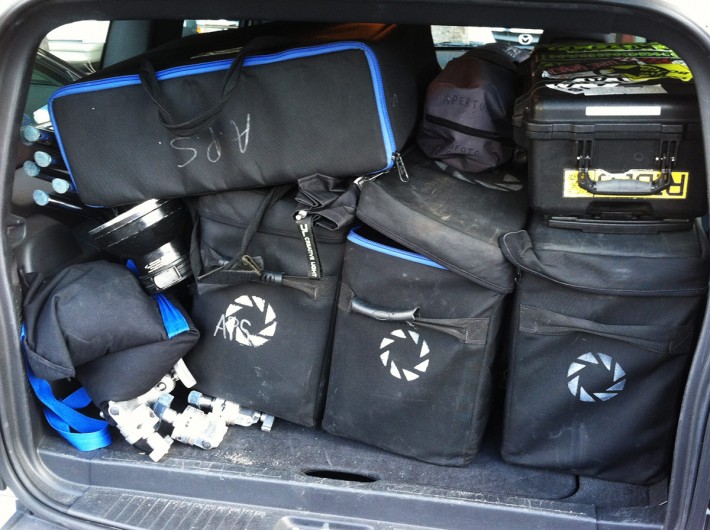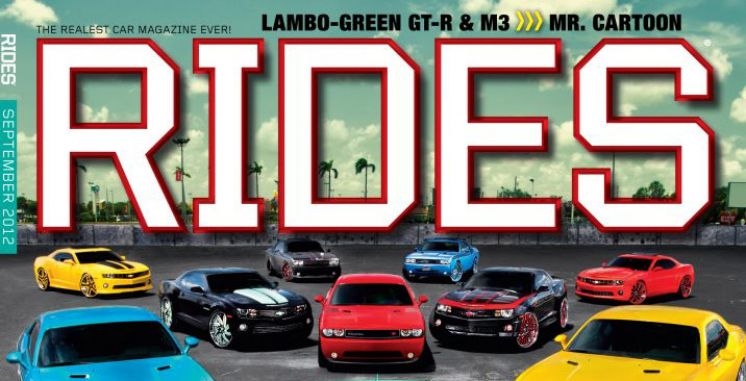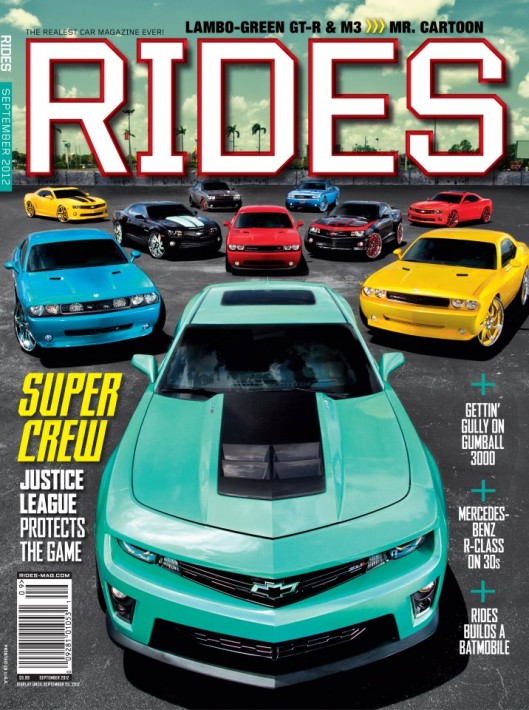Automotive Editorial Photography will teach you many things. Mostly though, it’ll teach you how to make something out of nothing and how to operate quickly and efficiently. I can’t tell you how many times I’ve shown up to shoot a car only to be told it can’t be moved from where it sits. It’s those situations that will really test your mettle as a photographer and I’ve actually grown to love those challenges. One challenge from last year that I really enjoyed was aRIDES Magazine cover that would require fitting and lighting 10 cars. Here’s how I did it.
I’d love to tell you that I showed up with a huge box truck full of every light and modifier imaginable to a pre-selected location that had a catering truck and an army of assistants, but it simply isn’t true. Anyone who does work for car magazines will tell you that the days of those kinds of budgets are pretty much long gone. Instead it was a Ford Explorer rental car with a few cases of gear we rented from a nearby rental house, a parking lot that belonged to a friend of the magazines publisher, and some Taco Bell.
It’s up to you to make something happen on these editorial shoots and you’re lucky if you can convince a friend to come out and assist. I was lucky on this day, I brought my good friend and go to guy in South Florida (also an incredible photographer), William Stern, out to help me. Will and I have worked together plenty in the past and have similar lighting styles so we know how to work for each other, which always makes shooting together a breeze.
Will and I met up the night before for our ritual dinner at a local Hooters; we’ve eaten Hooters literally every time I’ve gone down to Florida to shoot and it’s now just become our pre-shoot meal. We enjoyed some wings and went over cellphone photos of the cars to get an idea for how we would position and light them. We took care in our planning to make sure that the few cars that were similar colors were placed away from each other, that overlapping was kept to a minimum, and that as many wheels as possible were visible. After dinner we had our plan of attack.
The next morning the plan changed, as it always does. We showed up to the location, thankfully since it belonged to a friend of the publisher, we could close off the fenced in portion of the parking lot and be alone, and also guarantee we wouldn’t get kicked out by any sort of security or police. Most Automotive Editorial work is done without permits because usually they’re just too expensive to justify. You learn to shoot fast so you can be in and out of a spot before anyone really notices you’re there, a skill I’m actually thankful to have.
We pulled the gear out of the car, put the Profoto 7B heads on their stands, put the camera on my favoriteManfrotto tripod, which I’ve affectionately dubbed “the monster” because it’s over 10 feet tall, and waited for the cars. The cars were all members of the same car club, so they rolled in together. I climbed the ladder to the tripod and camera and we started guiding the cars into position.
One of the cars we originally planned for, the lead car for the cover, wasn’t there. After a quick talk with the guys in the club we found out it was laid up in a shop being worked on. Luckily, both Will and I had a relationship with the shop it was at, and they buttoned it up and brought it out to us. Crisis averted. That would have been a crushing blow to the cover. After all the money spent on flights, hotels and rental gear, we needed to have that car and thankfully we got it. We put the cover on the back burner for a while and shot the feature images we would need for the interior of the magazine while we waited for the ZL1 Camaro clone to arrive.
On to the photo.
There we were with a camera 10ft in the air and 10 cars carefully laid out before it. How were we going to light all of this?
We had four strobes at our disposal so compositing the image was definitely the way we had to go. Lighting this in one shot was going to be fairly impossible no matter how much gear we had. Also, the winds were picking up, making us uncomfortable leaving lights on stands unattended even with two and three sandbags holding them down. We huddled up and decided that Will was going to become a human light stand (my favorite kind of light stand for its ease of adjustment), for the day and we started firing off frames. Careful positioning of our light was going to be key to this whole shoot because the issue was going to print just a few days after I got back to New York to get to work on the retouching.
I had just two days after getting home to turn in the fully retouched cover and 26 images for the story, meaning I wasn’t going to be able to clean up any disasters in post or add light to something we missed. Using just one strobe and some careful Photoshop we were able to evenly light and give presence and dimension to these cars that wouldn’t have been possible with natural light.
Each car took about 4-5 frames combined to build a good exposure. After adding in exposures for the ground and sky I ended up with 56 layers just from the camera. After adjustment layers and clean up it ended up at 71 layers.
If you’ve stuck with me through all these words, here’s everything as an animated gif. You can see the base image and how all the layers fell together to make the cover shot.



